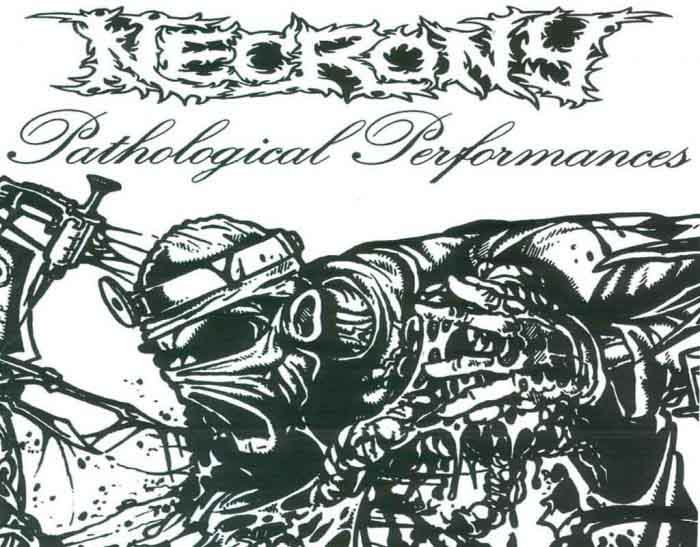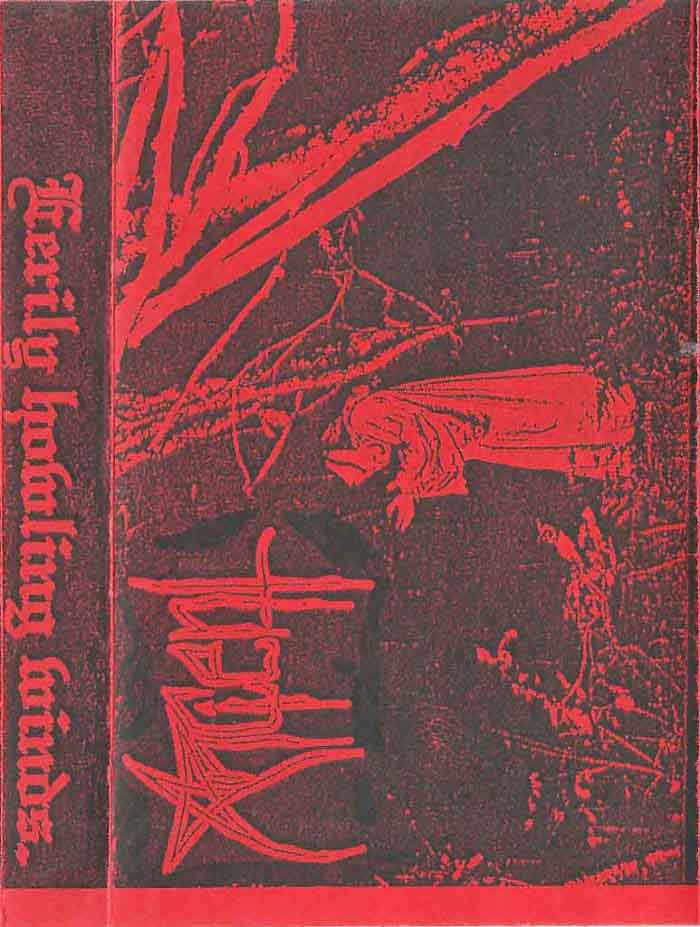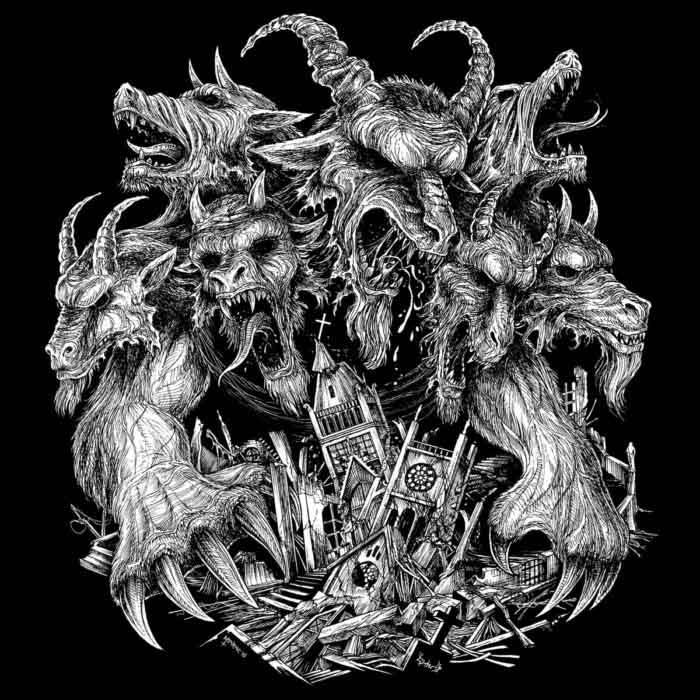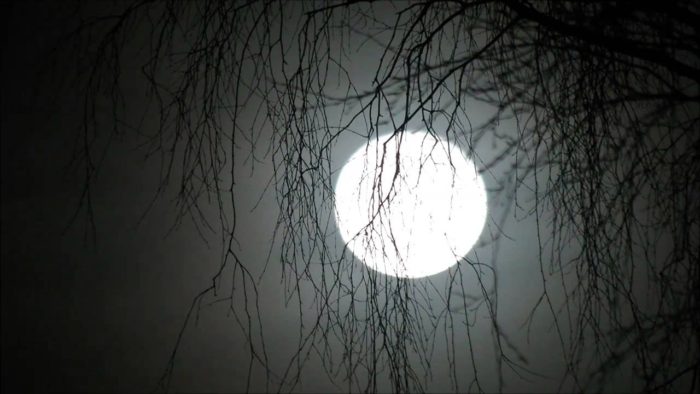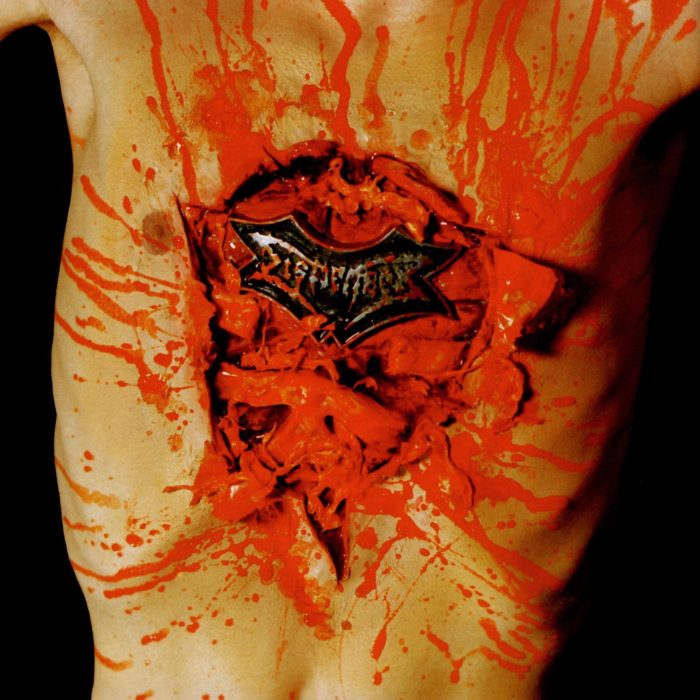One can find much to like on this later grindcore release, but it never quite gained traction in the canon. One wonders why, since it has Bolt Thrower and Carcass styled thunderous fairly technical grindcore, guttural vocals that sear ears and hope simultaneously, and carefully paced songs which accelerate for choruses.
1 CommentThrombus – Mental Turmoil (1993)
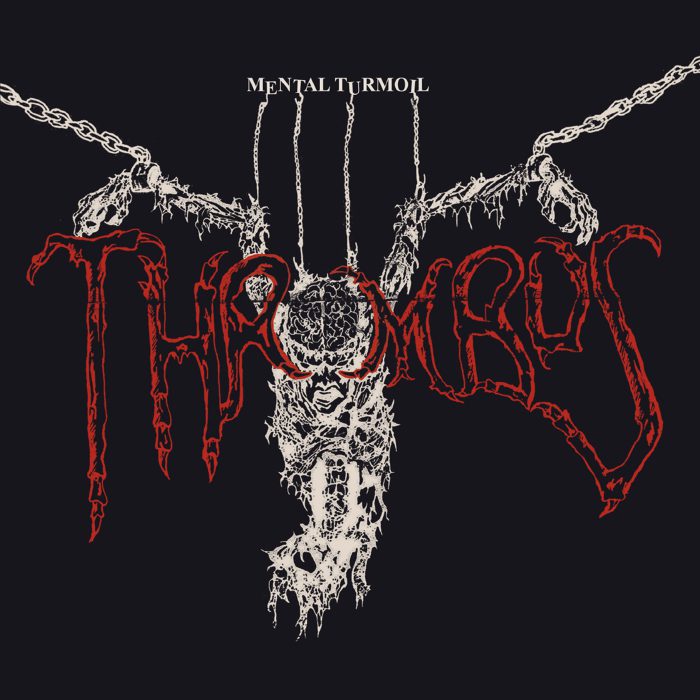
The present album is an example of undergorund death metal that, while humble and rather representative of the genre, does an excellent job of crafting good, concise music that delivers a strong experience effectively. Mental Turmoil shows us a band that has not liberated itself and is thus at the mercy of stronger influences, such as the more pensive side of U.S. death metal meeting the aggressive side of the more melodic European flavors —and one can hear echoes of an early Obituary somewhere in here, as well as other voices. Thrombus concots its own little mixture of influences, even if there is nothing quite original in it.
(more…)
Tags: 1993, 2018, death metal, la caverna records, mental turmoil, thrombus
Paramaecium – Exhumed of the Earth (1993)
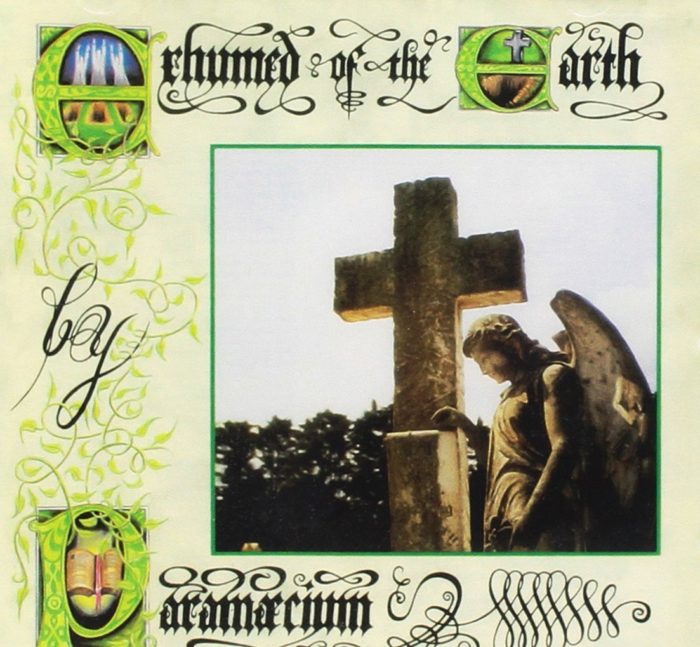
In addition to its notoriously contradictive definitional nature, doom metal remains something of an enigma in terms of its enduring popularity. Whether or not one chooses to view it as a distinctive subgenre, style or even technique, doom metal must bear one of the most in-proportionate quotas within metal music when it comes to quantity over quality. If attempting to depict doom metal from the perspective of enduring releases, the list of canonical works would become surprisingly short. It seems plausible that part of the explanation to this sad state is embedded in the very characteristics of the style. Doom bands have generally prioritized development of exceptionally powerful tools for conveying sonic heaviness at the expense of other aspects of the music. It might even be so that the techniques in themselves has forced artists into a particular way of writing music. Either way, there appears to be a widespread discrepancy between the means of expression and what is actually being expressed in doom metal; which in turn provides clues as to what makes for a genuinely satisfying doom-offering. With the above discussion in mind, today’s written offering presents the Australian death/doom act Paramaecium – one of few bands bearing the doom-tag that has managed to write compositions to match the sonic gravitas associated with said style.
(more…)
Tags: 1993, candlemass, death metal, deathdoom, Deus Vult, doom, Doom Metal, Exhumed of the Earth, Paramaecium, progressive, Samel, thematic continuity
Ancient – “Eerily Howling Winds” (1993)
As previously pointed out by the editor of this site, metal demo recordings does not exist as crass commercial propositions with the sole purpose of advertising the market viability of the artist, but function — at least ideally — as independent works produced and distributed without further infringement from the recording industry. In spite of eventual shortcomings resulting from lack of budget, experience, and time, demo-level recordings remain a breath of fresh air because they oftentimes capture bands at a nascent and untempered creative stage.
7 CommentsTags: 1993, Ancient, Black Metal, eerily howling winds, norway
Varg’s Black Metal History Video

Varg Vikernes has started posting a series of black metal history videos on his ThuleanPerspective Youtube channel. “About a day in 1993 that changed Black Metal forever” summarizes how Euronymous was completely unfit to run a business as a communist, bungled the release of the Burzum self-titled album, and how Euronymous’s clownishness ended his reign as the media’s go to spokesperson for the Norwegian black metal scene follow Varg’s arrest in connection with the church arsons.
64 CommentsTags: 1993, Black Metal, burzum, Euronymous, mayhem, metal history, norway, varg vikernes
Upcoming Demoncy – Faustian Dawn Reissue
Demoncy‘s second demo, 1993’s Faustian Dawn, is being reissued on CD and LP with new artwork from Chris Moyen by Nuclear War Now! Productions. Keep a look out.
3 CommentsTags: 1993, Black Metal, chris moyen, demo, demoncy, Faustian Dawn, nuclear war now! productions, reissue
Possessed by the Moon
Article by David Rosales.
A legendary time and place for underground metal, the Norway of 1993 is an esoteric landmark (1994 being the exoteric) in time and space in black metal history. It saw the rise of a mythology of its own, the mythology of black metal, and an eventual catastrophic demise worthy of a saga of its own.
25 CommentsTags: 1993, Black Metal, burzum, darkthrone, Det Som Engang Var, gorgoroth, norway, pentagram, Under a Funeral Moon
Dismember – Indecent and Obscene (1993)
Almost all metal bands eventually run out of ideas and revert to imitating their influences or repeating themselves. The former usually results in songs that are Frankenstein’s monster mashups of old ideas hoping to hop across the finish line without their sutures bursting leading to loss of limbs. The latter have no raison d’être beyond releasing the expected new record every eighteen months or so to put a product on the shelves that the label can push and the band can tour to support on a James Bond series type release schedule. Even a teenager saying “I want to kill everyone, drink beer, masturbate, and be as fucking metal as possible” shows more purpose than such aimlessness.
Indecent and Obscene was Dismember proving that in 1993 they had became at least as proficient musicians as their seventies and eighties idols. Dave Blomqvist took over the leader guitar duties from Nicke Andersson and added Mercyful Fate-like sweep-picked leads to the bluesy, Ritchie Blackmore-influenced solos. The songs continued in the vein of filthy Pieces EP with verse chorus verse bashers. The problem was they were slowed down, less distorted, and more lazily constructed: Beneath the Remains Sepultura minus a standard deviation or two in IQ. Every time Dismember play an interesting riff on this album, they allow it to wear out its welcome through repetition in brain-dead pop song structures. That is only when they have a good, counterpointed Carnage/Dismember riff. Most of the rhythm riffs are generic Autopsy riffs; riffs Autopsy stole from Celtic Frost, who stole it from Metallica, who stole it from some NWOBHM band who took it from AC/DC or The Stooges. These riffs were used just so Dismember could construct a basic d-beat song and sweep pick Guitar World readers’ faces off.
Matti Karki sounded just as rabid as ever but in every song sprouted off the title of the song in the chorus of the song as a vocal hook. This is the same as an awful Hollywood action film script containing dialogue saying the name of the movie in the movie, eg: “This is Con Air!” or “You Only Live Twice Mr. Bond!” Idiotic bridges kill off any tension too. “Why don’t you just kill yourself?” followed by breakdown of the main rhythm riff so all the hardcore kids for whom Suffocation was too heavy could slamdance before the air guitarable solo.
Dismember on Indecent and Obscene was Nuclear-Blasted into Cannibal Corpse before Nuclear Blast mandated all their bands sellout into death/black ‘n’ roll for the Bic-flicking festival crowd. While superior to most of the later work out of Sweden, Indecent and Obscene never approaches the transcendent Dark Recollections and Like an Ever Flowing Stream. The only praiseworthy aspects beyond the superficial icing are Fred Estby’s creative tom fills on songs such as “Sorrowfilled”. His underrated percussion is the only part building and resolving tension in these mediocre songs. That’s simply not enough to hold hessian attention. Decent material must still be composed and Dismember didn’t bother writing any worthy of repeated listening here.
14 Comments
Tags: 1993, beer metal, David Blomqvist, death 'n' roll, death metal, Dismember, Fred Estby, Matti Karki, nuclear blast records, pop metal, review, Speed Metal, Swedeath, Sweden, Swedish Death Metal
Reissue Radar: Blood – O Agios Pethane (1993)

Following up on Vic Records’ reissue of Christbait a couple months ago, Dunkelheit Produktionen from Germany is preparing a reissue of that album’s followup. O Agios Pethane also got a good review from the Dark Legions Archives at some point in the past and is presumably a worthy continuation of the band’s career in a similar style. The album is currently available for preorder from Dunkelheit’s online store and will be officially available on March 20th, 2016. Like its predecesssor, it should serve as a historic example of well written grindcore/death metal, although any band seeking to draw inspiration from it may need to also pull from other sources in order to produce something valuable.
3 CommentsTags: 1993, blood, death metal, German Death Metal, Grindcore, O Agios Pethane
On The Music of Demilich
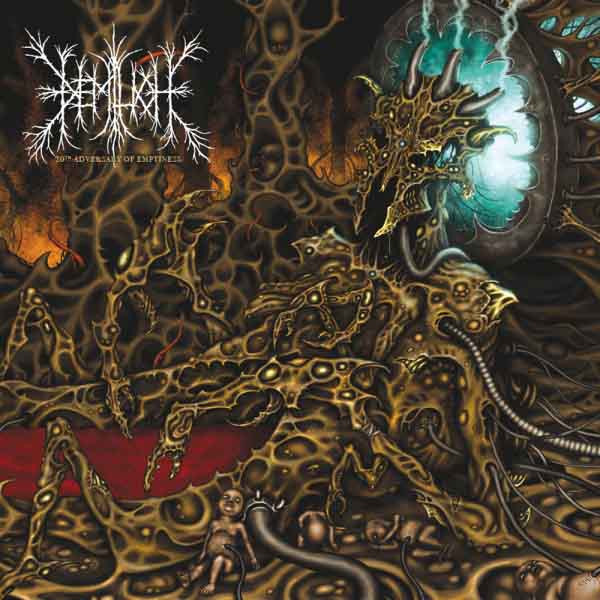
Article by David Rosales; get more perspective by also reading his article on Timeghoul
Much has been said about Demilich here and elsewhere, but remarkably little has been written about the potential of their music as ground for future bands to elaborate. For starters, the fact that Demilich has a solid fanbase and many admirers among professional musicians, but very few bands produce music in the same vein tells us that it is no easy task. This may also be due to the fact that most people tend to confuse appearances with mechanics, and mechanics in turn with character and essence. It seems to me that there is very little to elaborate, since Demilich is only distinctive at its very surface, in a very similar case to Immolation’s. Anything anybody may take from them besides this sort of surface plagiarism are the abstract concepts of loosening and playing with rhythm and mode consistently to achieve a distinctive sound. Perhaps even taking cues from their distinctive style could yield the foundation for the trademark sound of a younger band.
First, what makes Demilich stand out is their idiomatic approach to death metal that takes the best out of playing with tritones and off-putting harmonies in the context of the gore-flavored aura strand of the genre. Where Immolation goes for uncomfortable and dissonant, Demilich takes the modal/harmonic and rhythmic aspects of death metal to the extreme of this aural potential without incurring in the surface character deconstruction of Immolation’s coloring. Both of these bands, however, make use of standard death metal song-wide structuring techniques of the riff-salad kind with motific liaisons.
This surface extravagance coupled with an inner orthodoxy makes it very tricky for anyone to successfully extract the core of their teachings. In the case of Demilich even more so, since it is the silly side of their music’s character that stands out the most, making it particularly difficult to emulate them without producing obvious imitations. This may lead younger bands to think that a particularly derivative passage’s conspicuous appearance might be mitigated by mixing it into a hodgepodge of different styles and sounds. But to the perceptive listeners out there this will only sound like a motley fabric, a bag o’ tricks on display intended to fill in for actual content (Editor’s note: Have we told you about carnival music?).
Finally, superficial appreciation of the music of Demilich often leads fans to single out their music as “progressive”, as “opposed to traditional death metal”. Frequent readers of this site should immediately identify the grave mistake in this. Be that as it may, when you take the misunderstanding how progressive death metal in general is, and you put it together with the common metalhead’s idea of what progressive rock or metal is, you may begin to envision the monumental blunders that might come as a result.
Rather than insert Demilich-sounding passages into modern Dream Theater soundtracks, the young death metal musician might take head from the way Demilich balances out their outlandish sound. Demilich’s music, when seen at an abstract and aural level, can be divided into passages that are either more pounding, more syncopated or what we now call doom-laden (Demilich never stops too much in these power chord phrasal statements, though, so they do not really stand out). The emphasis on groove and the goofy-gore character is a constant that gives them their trademark sound.
The value of these concepts lies in learning how to produce sections that create variety within a narrative, with a distinctive and constant language that lends a personality of its own to the music. The narrative is produced through the equivalent of formal statements, developments, pauses for air, retaking of the topic, etc, in their musical manifestations. This is the greatest value of the best classic death metal bands: their outstanding ability to articulate.
28 CommentsTags: 1993, 20th adversary of emptiness, article, death metal, Demilich, Finnish Death Metal, musical analysis, nespithe
